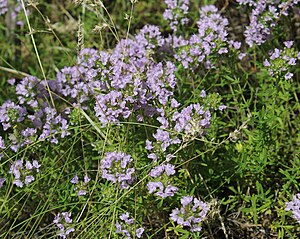Thymus kirgisorum
| Thymus kirgisorum | ||||||||||||
|---|---|---|---|---|---|---|---|---|---|---|---|---|

Thymus kirgisorum |
||||||||||||
| Systematics | ||||||||||||
|
||||||||||||
| Scientific name | ||||||||||||
| Thymus kirgisorum | ||||||||||||
| Dubj. |
Thymus kirgisorum is a plant type from the genus of thyme ( Thymus ) in the family of Labiatae .
description
Thymus kirgisorum is a small shrub whose flower-bearing stems are 3 to 5 (rarely up to 10) cm long. The leaves are (rarely only 5 to) 7 to 13 mm long and 0.8 to 1.5 (rarely up to 2) mm wide. They are leathery, short-stalked, linear-lanceolate to narrowly elliptical, blunt, entire and hairless, but densely dotted with glands. The base is ciliated. The midrib is clearly visible, the side veins are rather inconspicuous.
The bracts are more or less like the foliage leaves. The calyx is 3 to 4 mm long and densely dotted with glands. The upper teeth are no longer than 0.5 cm and are not ciliated.
Occurrence and locations
The species occurs from Russia and Ukraine to western Kazakhstan.
literature
- Thomas Gaskell Tutin et al. (Ed.): Flora Europaea. Volume 3: Diapensiaceae to Myoporaceae. Cambridge University Press, Cambridge 1972, ISBN 0-521-08489-X .
Individual evidence
- ↑ Rafaël Govaerts (ed.): Thymus kirgisorum. In: World Checklist of Selected Plant Families (WCSP) - The Board of Trustees of the Royal Botanic Gardens, Kew . Retrieved September 18, 2019.